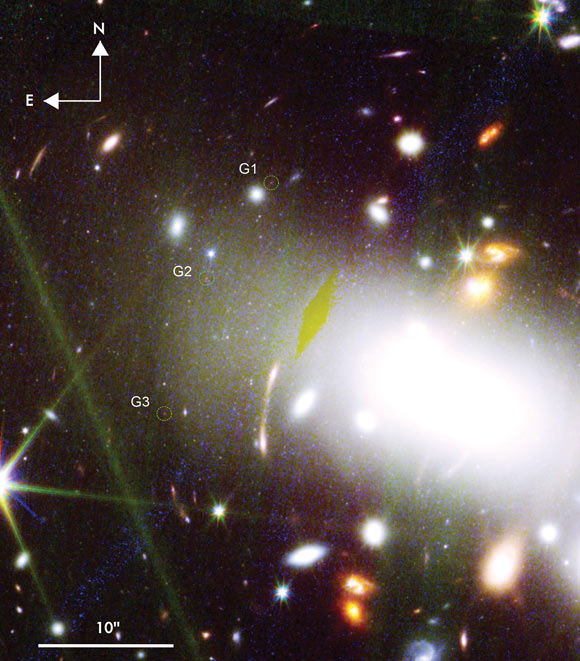The newly-discovered galaxy, named RX J2129-z95, appears as three images due to the gravitational lensing of the foreground galaxy cluster RX J2129.6+0005. This galaxy had a diameter of 32.4 parsecs (106 light-years) and existed when the Universe was just 510 million years old.

Color-composite image of the galaxy cluster RX J2129.6+0005; green circles indicate three lensed images of the dwarf starburst galaxy RX J2129-z95. Image credit: Williams et al., doi: 10.1126/science.adf5307.
It is thought that the Universe was once opaque, dominated by dense neutral hydrogen filling intergalactic space.
Light from the earliest galaxies gradually reionized the majority of the gas in the intergalactic medium, transforming the Universe and making it transparent.
However, the precise timeline of reionization and the relative contributions of the Universe’s earliest galaxies to this process remain uncertain.
“RX J2129-z95 is far beyond the reach of all telescopes except the NASA/ESA/CSA James Webb Space Telescope, and these first-of-their-kind observations of the distant galaxy are spectacular,” said Dr. Patrick Kelly, an astronomer at the University of Minnesota.
“Here, we’re able to see most of the way back to the Big Bang, and we’ve never looked at galaxies when the Universe was this young in this level of detail.”
“The galaxy’s volume is roughly a millionth of the Milky Way’s, but we can see that it’s still forming the same numbers of stars each year.”
Webb can observe a wide enough field to image an entire galaxy cluster at once.
Dr. Kelly and his colleagues were able to find and study this new, tiny galaxy because of a phenomenon called gravitational lensing — where mass, such as that in a galaxy or galaxy cluster, bends and magnifies light.
A galaxy cluster lens caused this small background galaxy to appear 20 times brighter than it would if the cluster were not magnifying its light.
The astronomers then used spectroscopy to measure how far away the galaxy was, in addition to some of its physical and chemical properties.
“The galaxies that existed when the Universe was in its infancy are very different from what we see in the nearby Universe now,” said University of Minnesota Ph.D. student Hayley Williams.
“This discovery can help us learn more about the characteristics of those first galaxies, how they differ from nearby galaxies, and how the earlier galaxies formed.”
Webb can collect about 10 times as much light as the NASA/ESA Hubble Space Telescope and is much more sensitive at redder, longer wavelengths in the infrared spectrum. This allows astronomers to access an entirely new window of data.
“Webb has this amazing capability to see extremely far into the Universe,” Williams said.
“This is one of the most exciting things about our study.”
“We’re seeing things that previous telescopes would have ever been able to capture.”
“It’s basically getting a snapshot of our Universe in the first 500 million years of its life.”
The findings appear today in the journal Science.
_____
Hayley Williams et al. A magnified compact galaxy at redshift 9.51 with strong nebular emission lines. Science, publihsed online April 13, 2023; doi: 10.1126/science.adf5307







